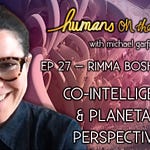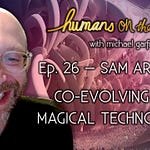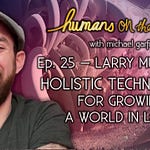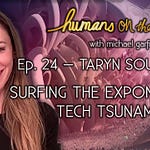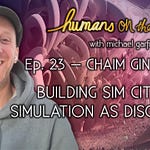This week’s episode is the first of a special two-part conversation with Dr. Mark Nelson, one of the eight “biospherians” who lived for two years inside the closed ecological network Biosphere 2 – one of the most ambitious experiments ever performed, the reproduction of five distinct biomes inside a building in the Arizona desert. Mark is the author of the newly-published history of his experience in Biosphere 2, called Pushing Our Limits – he’s also the author of The Wastewater Gardener, which applies the same closed-loop, full-system ecological thinking to more easily attainable forms of agriculture.
I know Mark through my lucky acquaintance with Synergia Ranch just outside Santa Fe (where I am right now, editing this episode) – the home base for The Institute of Ecotechnics, the group that pioneered the discipline of “Biospherics,” and the hub for a planetary network of brilliant, passionate, eclectic individuals whose stories never cease to blow my mind. Mark’s tale of his two years living under glass with seven other brave souls is powerful, inspiring, and full of potent lessons for both life on Earth and life in space.
We Discuss:
– How theater can save a tight team from decaying into “kill the leader” reflexes and the importance of drama to living a full human life;
– Gerard O’Neill and the Space Studies Institute, Stewart Brand and the Whole Earth Catalog, and how space exploration went in, then out, then back into fashion;
– Biospheres are materially closed but energetically open;
– The study of comparative biospheres;
“If anyone’s running the show, it’s the microbes. It’s a reality that’s actually quite joyful to realize. You are NOT an island. We are totally enmeshed biologically in the biosphere.”
– Carrying around the trauma from the Great Oxygenation Event in our intestinal microbiota;
– Biomes as the building blocks of a biosphere;
– The Research Vessel Heraclitus, the Institute of Ecotechnic’s rehabbed Chinese junk, exploring the World Ocean;
– How they designed “lungs” for the building to enable pressure differences inside the building;
“Life transforms the planet. And in fact, when we look out, we’re looking at the by-products of life. And even a lot of what used to be thought of as mineral deposits – these huge deposits of iron, for example, used to be considered to be ‘natural’ formations, ie, geologic ones. No! In fact, [it was the work of] ‘slime’…juicy, fecund with life.”
“I think we need a whole new generation of creative people to give us the storylines for new outcomes. I kind of borrow from William Burroughs, who said, ‘We need a new mythology for the Space Age.’ And he further said that we’re going to judge heroes and villains by their intentions toward the planet.”
– Synergy (popularized by Buckminster Fuller) and synergy in life and love;
– Saving his sanity with “Hallucinogenic Outback Comedies” and using original plays and dances to communicate nonverbally around the world
“In the negative news stories, they would say, ‘These aren’t scientists, these are recycled actors from New Mexico.’ Well, Biosphere 2 was an in-life production…I have some friends who say that Biosphere 2 was John Allen’s greatest theater production. We really thought it was going to be a quiet research facility.”
“Thinking is hard. But PRETENDING to think, I can do that really well.”
“The opposite of an actor is a RE-actor.”
– Theater as a way of escaping the person you are at 7 AM
“I’ve had the great pleasure of meeting quite a number of astronauts and cosmonauts…and they’re all changed men.”
– The first and second Inter-Biospheric Festivals
“Our culture, I think, and it may have a malevolent intent in doing so, tends to diminish people’s expectations of what they personally can do.”
Support this show http://supporter.acast.com/futurefossils.
Hosted on Acast. See acast.com/privacy for more information.




